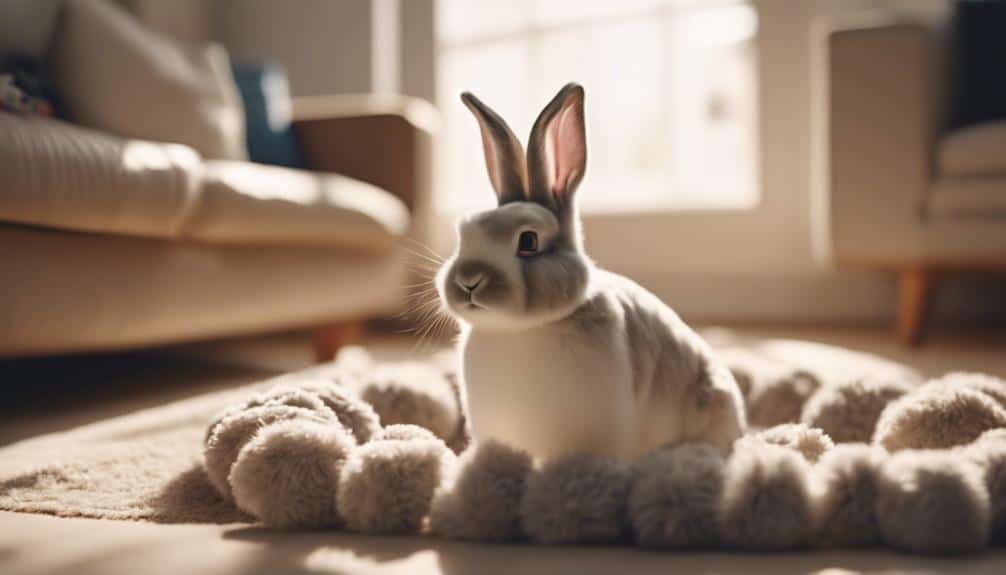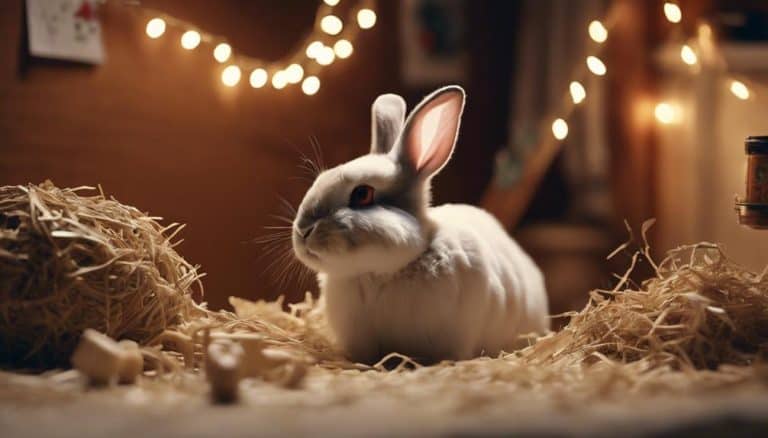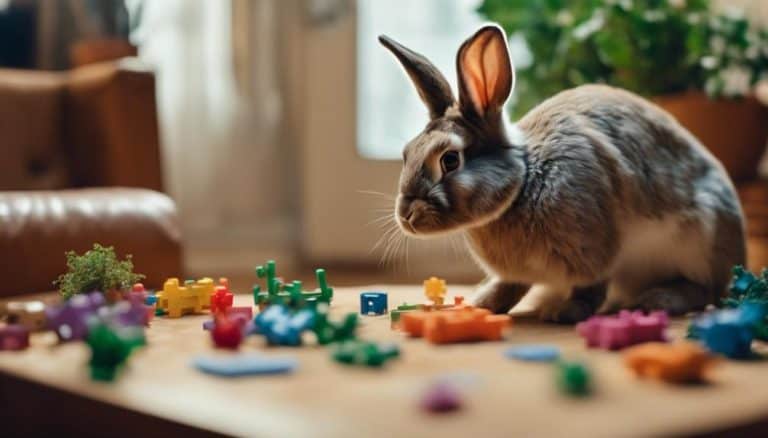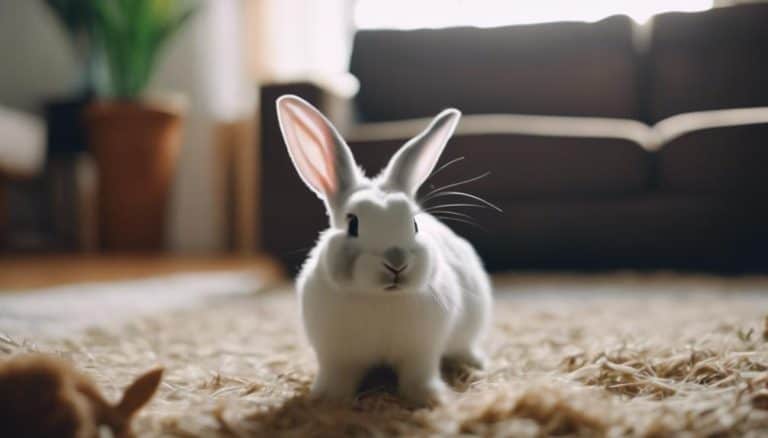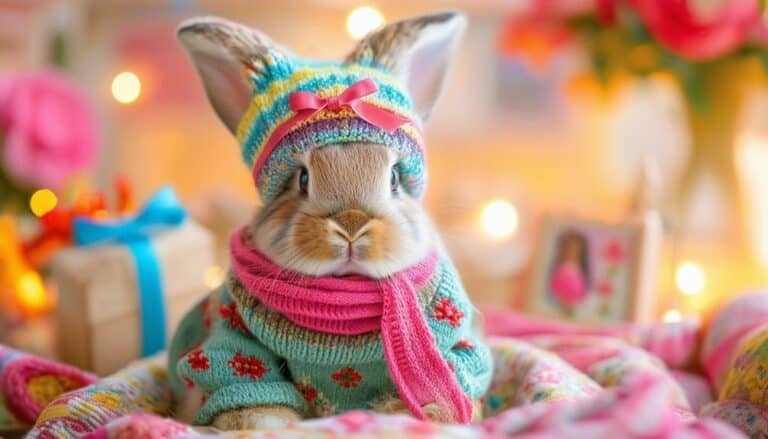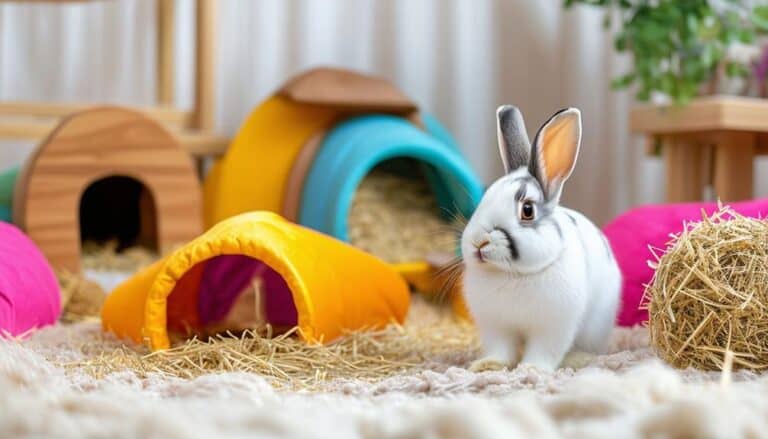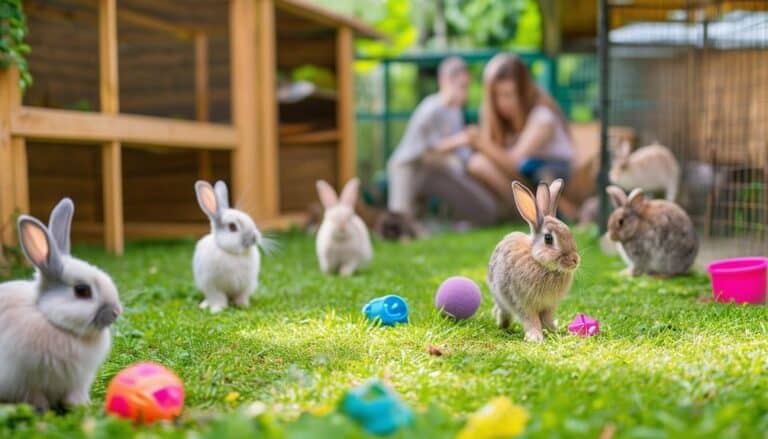Why Is My Pet Rabbit Running in Circles?
When you notice your pet rabbit running in circles, it might leave you curious and slightly concerned. This behavior can stem from various reasons, such as seeking your attention, displaying playful energy, or even engaging in courting rituals.
Understanding why your rabbit circles is important for interpreting its needs and ensuring its well-being. Are they simply excited, or could there be something more significant at play? To truly grasp the motivations behind this curious habit, let’s explore the common triggers and what they might signify about your rabbit’s health and emotional state.
Understanding Bunny Circling
Recognizing bunny circling as a behavior that signifies affection or a bid for attention from your rabbit is crucial. This behavior is a key aspect of Rabbit Body Language, indicating that your domestic rabbit is engaging positively with you. When your rabbit runs in circles around your feet, it’s often accompanied by soft oinking or buzzing sounds. These auditory signals, coupled with the circling movement, demonstrate that your rabbit is in a positive, energetic mood.
In the context of rabbit behavior, circling is non-destructive and playful. Notably, nipping at your ankles during this activity is typically not aggressive. Instead, it’s an extension of their playful demeanor. Understanding these behaviors allows you to respond correctly.
Providing positive reinforcement such as treats, petting, or engaging in interactive playtime can strengthen your bond and encourage this affectionate behavior.
Common Reasons for Circling
Recognizing and interpreting your rabbit’s circling behavior can help identify several common reasons behind this action. When you observe your rabbit running in circles, you may notice it’s often a demonstration of a positive, energetic mood. This behavior is frequently employed by rabbits to seek attention from their human companions, indicating a desire for interaction or affection.
Another prevalent reason for circling behavior is the anticipation of treats. Rabbits quickly learn that circling you or their enclosure can result in a rewarding treat. This conditioned response is non-destructive and can be positively reinforced with consistent rewards, making it a beneficial behavior to encourage.
Additionally, circling can serve as a form of greeting. If your rabbit circles you upon entering a room, it’s their way of saying hello and expressing excitement. This interaction fosters a strong bond and enhances your relationship with your pet.
Understanding these common reasons allows you to effectively address and respond to your rabbit’s needs. By recognizing that your rabbit’s circling behavior is often about seeking attention, you can provide the appropriate engagement, ensuring your rabbit remains happy and well-stimulated.
Courting Behavior in Rabbits
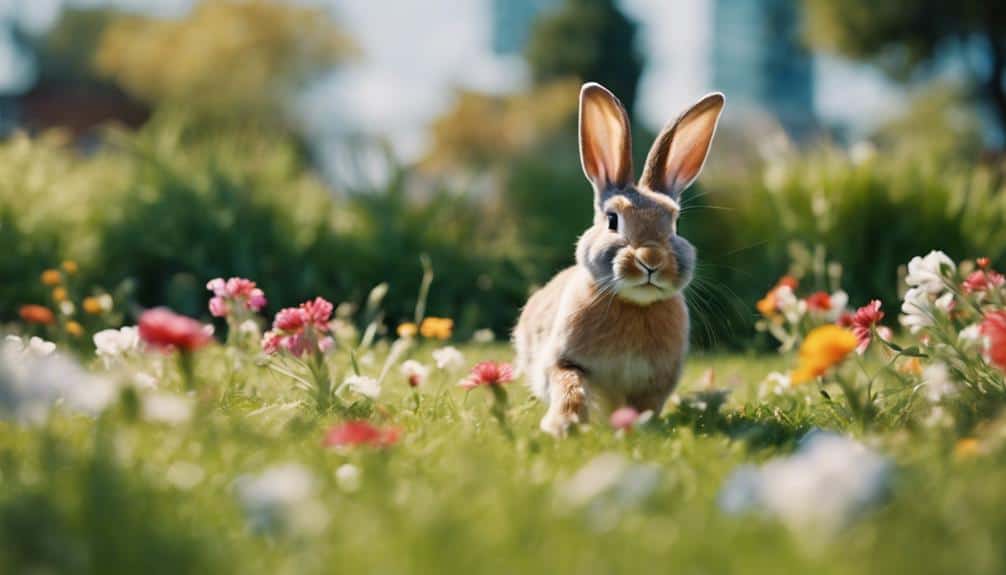
Circling behavior in rabbits often signifies courtship, particularly when accompanied by humming noises, increased activity, and territorial marking. In the context of courting behavior, running in circles around a potential mate is a display of interest and affection. This natural instinct is deeply ingrained in rabbits, and it’s a way for them to communicate their readiness to mate.
When your rabbit starts running in circles around you or other rabbits, it’s often more than just playful activity. The humming noises they produce are part of this intricate courting dance, signaling their intentions. Alongside these behaviors, you might notice your rabbit engaging in territorial marking, such as pooping around the area. This is another layer of their courtship ritual, establishing dominance and signaling their presence to potential mates.
Understanding these hormonal changes and natural behaviors can help you interpret your rabbit’s actions more accurately. By recognizing the signs of courting behavior, you can better manage your pet’s environment and interactions. This knowledge not only aids in providing a harmonious living space but also enhances your ability to connect with your rabbit on a deeper level.
Attention-Seeking Actions
When your rabbit circles your feet, it’s likely seeking your attention and expressing excitement. This behavior, often accompanied by oinking or buzzing sounds, indicates a craving for social interaction.
Reinforce this positive behavior with treats, play, and petting while ensuring you don’t accidentally harm your pet.
Seeking Owner’s Attention
Your rabbit’s circling behavior often serves as a clear indicator of its need for your attention and interaction. When a rabbit runs in circles, it’s typically seeking attention from its owner. This behavior manifests as a direct request for engagement, whether it be through petting, playtime, or treats. Clinically, this can be identified as a vital, necessary expression, showcasing your rabbit’s desire for social interaction.
From a diagnostic perspective, it’s important to recognize that such behavior is an attempt to communicate. When your rabbit runs in circles around you, it’s essentially seeking a response. Ignoring this can lead to frustration for your rabbit, potentially escalating into more disruptive behaviors. Thus, promptly responding to their attention-seeking actions can reinforce positive behavior patterns and strengthen your bond.
Engagement strategies can include gentle petting, interactive toys, or offering a small treat. It’s crucial to ensure these interactions are consistent and rewarding. By doing so, you not only address your rabbit’s immediate need for attention but also foster a more trusting and affectionate relationship.
Understanding this behavior allows for a deeper connection, promoting a harmonious coexistence based on mutual respect and understanding.
Expressing Excitement Playfully
Rabbits often exhibit circling behavior as a clear expression of playful excitement and a desire for interactive engagement. When your rabbit is running in circles around your feet, it’s typically a sign they’re in a joyous mood and looking to play. Accompanying behaviors might include making buzzing or oinking noises, which further indicate their excitement.
To understand and respond to this behavior effectively, consider the following table:
| Behavior | Interpretation |
|---|---|
| Running in circles | Playful excitement |
| Buzzing or oinking | High excitement level |
| Nipping ankles | Playfulness, not aggression |
| Responding with treats | Reinforces positive behavior |
Your rabbit’s running in circles is a positive behavior that you can encourage through interaction. Offer treats, engage in play, and pet them to reinforce their actions positively. However, be mindful of nipping; while it’s playful, responding with a yelp can discourage this behavior without reinforcing it.
Understanding these behaviors allows you to foster a more enriching environment for your rabbit, ensuring their playful excitement is met with appropriate and positive responses. Remember, their circles and running are just their way of saying they’re ready to engage and have fun!
Craving Social Interaction
A rabbit running in circles often signals a strong desire for social interaction, indicating a need for engagement, companionship, or play. When your pet rabbit exhibits this behavior, it’s essential to recognize it as a craving for social interaction. This behavior often serves as a diagnostic cue that your rabbit may be seeking:
- Engagement or Play: Rabbits are social animals that thrive on interaction. Running in circles can be their way of inviting you to play or engage with them.
- Human Companionship: Just like other pets, rabbits enjoy the company of their human companions. This action can signify that your rabbit wants more time with you.
- Mental Stimulation: Lack of mental engagement can lead to this repetitive behavior. Ensuring your rabbit has stimulating toys or activities can alleviate this need.
- Positive Reinforcement: Sometimes, rabbits run in circles to gain treats or affection. Positive reinforcement can help satisfy this craving for attention.
Recognizing these signs and addressing them appropriately can strengthen your bond with your pet rabbit. Providing ample playtime, social interaction, and mental stimulation won’t only satisfy their craving for social interaction but also contribute to their overall well-being.
Hormonal Influences
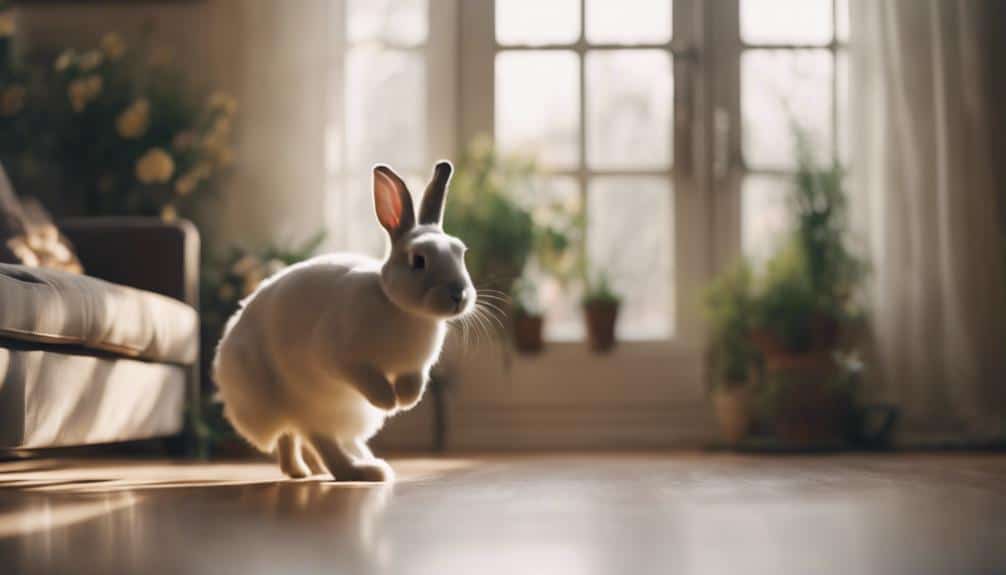
During mating season, hormonal changes often drive pet rabbits to exhibit circling behaviors as a form of courting dance. These hormonal influences, primarily reproductive hormones, play a vital role in your rabbit’s sudden urge to run in circles.
When a rabbit reaches sexual maturity, these behaviors become more pronounced, as the animal’s body is flooded with hormones like estrogen or testosterone, compelling it to display signs of interest and dominance.
You might notice your rabbit running in circles around your feet or another rabbit, which is a clear indicator of heightened hormonal activity. This behavior is basically a communication mechanism, signaling readiness for mating and exerting dominance to attract a potential partner.
It’s important to recognize that these behaviors are natural and hormonally driven, especially if your rabbit hasn’t been spayed or neutered.
However, if these hormonal fluctuations are causing disruptive behavior, spaying or neutering your rabbit can greatly mitigate these tendencies. This surgical intervention helps stabilize hormone levels, subsequently reducing the intensity and frequency of circling behaviors.
Territorial Marking
While hormonal influences play a significant role in your rabbit’s circling behavior, another critical factor to take into account is territorial marking. Rabbits have scent glands located in their chins, and they use these glands to mark their territory. When your rabbit expects to establish boundaries or assert dominance in its living space, it may exhibit circle-running behavior. This is a natural instinct, particularly prevalent in unneutered rabbits.
To understand this behavior better, consider these key points:
- Scent Glands Usage: Your rabbit uses its scent glands to leave a unique scent around its territory, signaling ownership to other rabbits.
- Boundary Establishment: Circle-running is a visual and olfactory method for your rabbit to outline its territory.
- Hormonal Influence: Territorial marking is often intensified by hormonal changes, making it more common in unneutered rabbits.
- Behavioral Outlets: Providing appropriate outlets, such as chew toys and designated areas for your rabbit to mark, can help mitigate excessive circling.
Assessing Rabbit Health
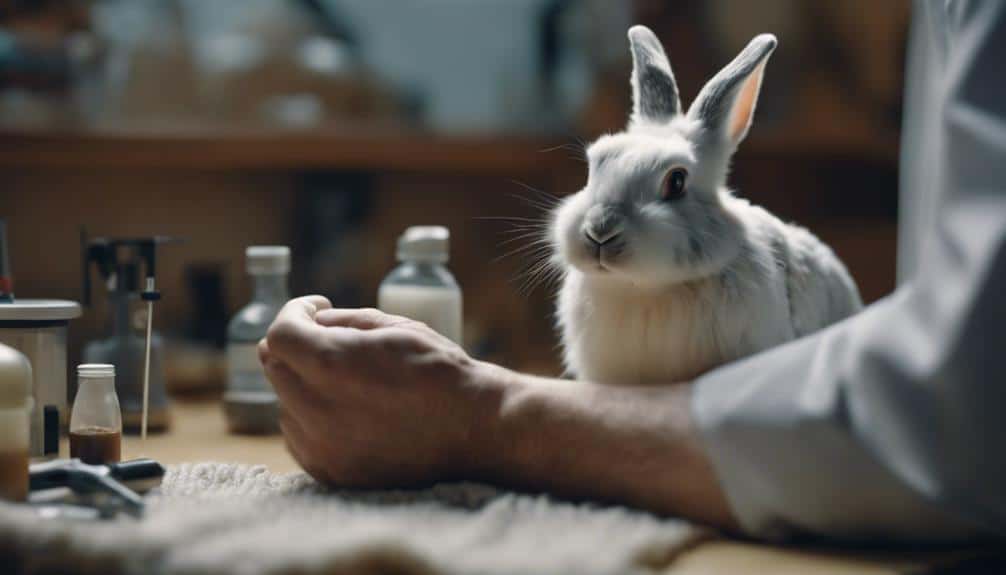
Evaluating your rabbit’s health is vital when you notice circling behavior, as it could indicate underlying conditions like vestibular disease. Vestibular disease presents with symptoms such as head tilting, enlarged eyes, and turning in circles. This condition stems from various causes, including protozoal and bacterial infections, strokes, or ear and brain stem injuries.
To guarantee effective rabbit care, promptly consult experienced rabbit vets. They possess the expertise to conduct a thorough diagnostic approach, which may include physical examinations, blood tests, and imaging studies like X-rays or MRIs. Early intervention is essential for improving prognosis and tailoring treatment plans based on the specific cause of vestibular disease.
In the meantime, make your rabbit’s environment safer by adding padding to their enclosure. This simple step helps prevent injuries from disorientation and falls. Remember, timely veterinary care not only alleviates symptoms but also prevents further complications.
Don’t rely on general advice; instead, seek out experienced rabbit vets who specialize in small animal medicine. A targeted diagnostic approach ensures your rabbit receives the best possible care, addressing both immediate symptoms and underlying causes effectively.
Spaying and Neutering Benefits
Spaying and neutering your rabbit can greatly reduce hormonally driven behaviors like aggression and territorial marking. These procedures also lower the risk of reproductive organ-related diseases, enhancing your rabbit’s overall longevity.
Hormonal Behavior Reduction
Reducing hormonal behaviors in pet rabbits, spaying and neutering offer numerous benefits, including decreased territorial marking and aggression. Spaying your female rabbit is particularly effective in hormonal behavior reduction. By removing the ovaries and uterus, you eliminate the primary sources of hormones that drive aggressive and territorial behaviors. This procedure not only curtails circling but also prevents false pregnancies, making your rabbit more relaxed and manageable.
Neutering male rabbits similarly reduces undesirable hormonal behaviors. Testosterone levels drop, which diminishes urine spraying and aggressive tendencies. After neutering, your male rabbit will be less likely to engage in mounting and other dominance displays.
Here are some key benefits of spaying and neutering your rabbit:
- Reduced Territorial Marking: Both male and female rabbits are less likely to mark their territory with urine and feces.
- Decreased Aggression: Lower hormone levels mean fewer aggressive outbursts.
- Improved Litter Box Habits: Spayed and neutered rabbits have better control over their bathroom habits.
- Calmer Demeanor: Hormonal behavior reduction leads to a more relaxed, friendly pet.
Health and Longevity
Why does spaying or neutering greatly improve your rabbit’s health and longevity?
Spaying or neutering your rabbit is a critical step in guaranteeing a longer, healthier life. This procedure directly addresses and prevents reproductive health issues that commonly plague unaltered rabbits. For instance, spaying a female rabbit eliminates the risk of uterine cancer, a prevalent and often fatal condition. Similarly, neutering a male rabbit can prevent testicular cancer and decrease aggressive behaviors such as running circles around you, which is often a display of hormonal-driven activity.
From a clinical perspective, spaying or neutering also mitigates the likelihood of other health complications. By removing the reproductive organs, you effectively diminish the risk of potentially life-threatening infections like pyometra in females. Additionally, neutering males can help decrease territorial marking, which can lead to a more harmonious living environment.
Diagnostic approaches show that altered rabbits exhibit fewer behavioral issues and enjoy enhanced overall well-being. This translates to a more peaceful coexistence and a lower likelihood of stress-induced health problems.
Conclusion
By understanding your rabbit’s circling behavior, you can better address their needs and guarantee their well-being. Whether it’s playful energy, attention-seeking, or hormonal influences, recognizing these actions helps you respond appropriately.
Consider spaying or neutering to mitigate hormonal behaviors and improve overall health. Always monitor your rabbit’s health and consult a veterinarian if you notice any unusual patterns.
Strengthening your bond through attentive care is key to a happy, healthy rabbit.

